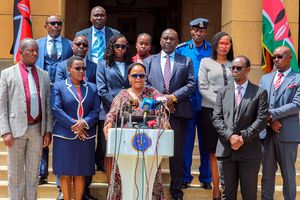
Education Cabinet Secretary Ezekiel Machogu (center) flanked by his Principal Secretaries Dr Esther Thaara Muoria and Dr Belio Kipsang during the launch of the 4th National Education Sector Strategic Plan in Nairobi on June 6, 2024.
With only three weeks left to the end of the current financial year, the government has not remitted billions of shillings meant for various education programmes, a situation that complicates their operations and delivery of service in the sector.
The delays affect secondary schools as well as colleges offering technical and vocational education and training (Tvet) as well as universities. Only primary schools have received the expected amount.
However, Education Cabinet Secretary Ezekiel Machogu on Thursday gave figures of the unremitted money that contradict what administrators of the institutions claim to have received.
“We’ve so far given schools fifty per cent [of the capitation] and this term we’re giving another thirty per cent and in third term, we’ll give the remaining twenty per cent. We don’t have any problem in universities and moving forward before the end of the year, we’ll release some more money,” Mr Machogu said on Thursday at the Kenya School of Government in Kabete when he launched the 2023-2027 National Education Sector Strategic Plan.
However, the CEO of the Higher Education Loans Board (Helb) Charles Ringera on Tuesday told the National Assembly Committee on Education that the higher education sub-sector is owed Sh29 billion in unremitted funding in the current financial year that comes to an end in three weeks’ time.
He said Higher Education Principal Secretary Beatrice Inyangala is following up the matter with the National Treasury.
Many universities have already closed their academic year while examinations are going on in others.
This means that students have gone through the semester without receiving the full amounts of money due to them.
Helb has so far received Sh30.2 billion from the Exchequer meant for students’ loans but has a balance of Sh6.7 billion.
The Universities Fund is yet to remit Sh16.5 billion to universities. Of this, Sh7.9 billion is for scholarships to first years under the higher education model introduced last year and the remaining Sh8.6 billion is for grants to universities for continuing students.
Technical and Vocational Education and Training (Tvet) institutions are owed Sh4.2 billion in scholarships for first year students under the funding model and Sh1.6 billion in grants for continuing students.
“The delays in disbursement of scholarship and loans funds have significantly impacted operations in higher learning institutions, causing disruption and financial strain. Consequently, they are left grappling with financial uncertainty, which directly affects the quality of education and overall operations,” Dr Inyangala said.
The chair of the Kenya Secondary Schools Heads Association Willy Kuria also disputed Mr Machogu’s assertion that schools received 50 per cent of capitation in first term.
The Ministry of Education disburses capitation in three traches at the ratio of 50:30:20.
“It was not fifty per cent. It was slightly over Sh8,000 per student. We also have issues with what was received because it’s for tuition only and not infrastructural development, yet schools have infrastructural needs,” he told Nation.
Many schools have had to rehabilitate infrastructure that was destroyed by floods to allow for learning.
Destroyed infrastructure includes classrooms and sanitation facilities. Mr Machogu said that members of Parliament were given a funding of Sh18million each last week from the National Government Constituency Development Fund.
He urged them to utilise the emergency allocation for schools infrastructural development.
The government allocates Sh22,244 per learner under the Free Day Secondary Education (FDSE) and Sh1,420 per learner under the Free Primary Education programme.
However, the funding for the FDSE has fallen to about Sh17,000 per learner as enrolment growth has not been matched with budgetary allocation and Exchequer releases.
Read: Wasted millions - Ministry of Education on the spot as learners, parents shun public institutions
The chair of the Kenya Primary Schools Heads Association Johnson Nzioka confirmed to Nation that the schools have received the 50 per cent disbursement.
Mr Machogu said that the government plans to construct between 16,000 and 18,000 classrooms to accommodate learners who will be in Grade 9 in junior school.
He said Sh3.5 billion has been released for construction of 3,500 classrooms that should be complete in four months.
Meanwhile, the government plans to spend Sh5.02 trillion on education programmes in five years but will only raise Sh3.47 trillion for the ambitious plan.
The education sector always takes the largest share of the national budget and the 2023-2027 National Education Sector Strategic Plan launched on Thursday has a funding gap of Sh1.55 trillion that Mr Machogu says will come from development partners and household contributions.
The State Department for Higher Education has the highest deficit (Sh932.1 billion) over the five-year period, followed by the State Department for Basic Education (Sh388.2 billion).
The Teachers Service Commission has a deficit of Sh174 billion while the State Department for TVET has a shortfall of Sh25.8 billion.










